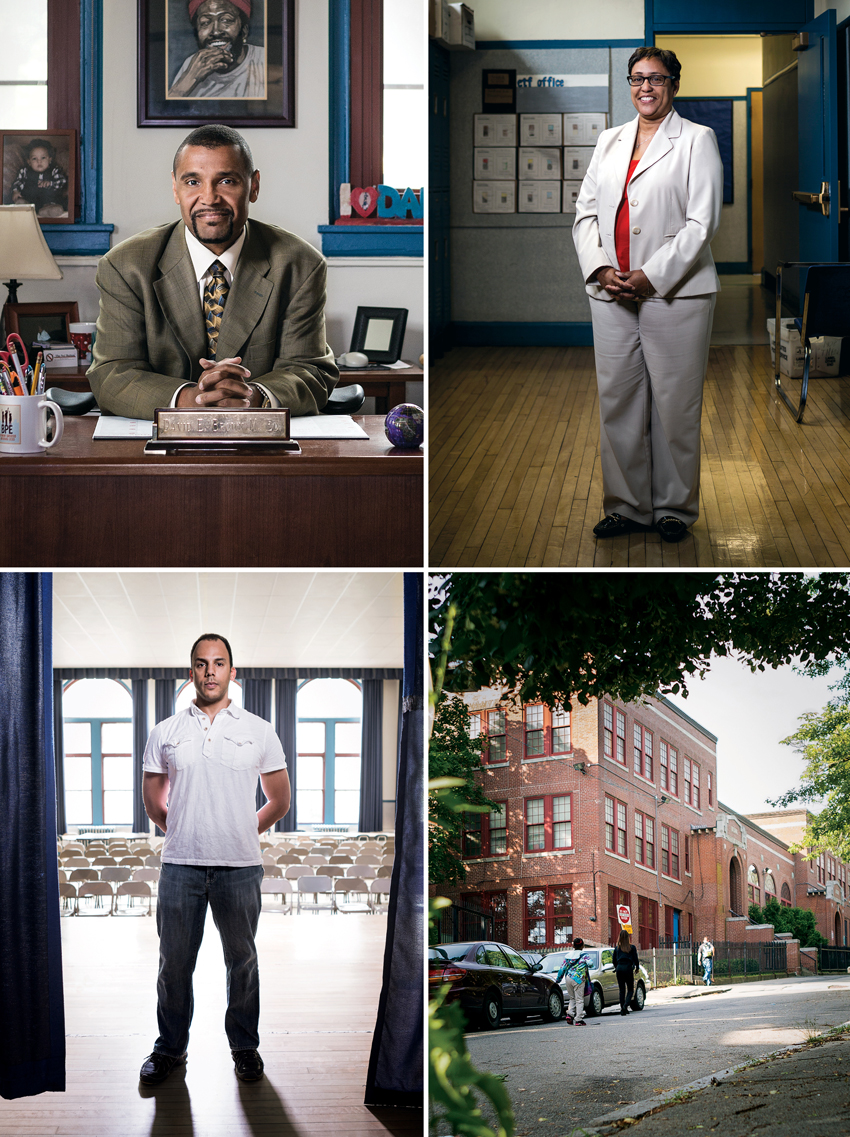A Tale of Two Boston Schools: Orchard Gardens and Higginson/Lewis

Clockwise from top left, Higginson/Lewis assistant principal David Brown; Lena Reddick, the director of community and partnership; the school itself; and teacher Jason Wise. / Photographs by Trent Bell
THE HIGGINSON/LEWIS’S STRUGGLES began with a merger. The Lewis was once an unofficial feeder school for the Boston Arts Academy, but wrinkles in the system had assigned it a disproportionate share of children with behavior problems, or kids whose parents didn’t know how to be involved. “The Lewis school was the dumping ground for kids in the city,” says Reverend David Wright, who is the executive director of the Black Ministerial Alliance of Greater Boston and has a daughter at the Higginson/Lewis. “If you had a parent who didn’t choose a school, you ended up here. If you were a new immigrant to the city and they had no place to put you, they put you here. If you didn’t choose anywhere to go or if you were cruising to no man’s land, this was where you ended up.”
The Higginson Elementary School, just four blocks away, had been small, cozy, and well ordered, a place where every teacher not only knew every student, but also knew about them and their families. In 2009, its kids and staff also ended up at the Lewis.
“There was no plan,” says Salesman-Oliver, who’d been the Higginson’s principal and was asked to take over the newly merged school. “They didn’t hand me a book that said, ‘This is how you make a K–8 school.’ In some cities you get a whole year to plan a new school, to talk to parents, hire staff, whatever. Here? Six weeks over the summer.”
Salesman-Oliver, who grew up in Roxbury in a tight-knit Jamaican family, is a BPS veteran, which may explain her matter-of-fact cynicism about the system’s bureaucracy. The day she and her colleagues arrived at the Lewis was an eye-opener. “When we got here,” Salesman-Oliver says, “nothing was fixed. It was like time had stopped on the last day of school.” They found the school’s furniture and supplies jumbled up in the auditorium. Some classrooms were bare, while others were piled to the ceiling with books and furniture. The cafeteria had nothing—not a table or a chair—and remained empty, despite repeated calls to central offices, until the day school opened.
These were annoying but relatively straightforward issues, fixable with sweat and some very long days. Much harder was trying to impose on the joint school, with its volatile mix of big and little kids, and of teachers who barely knew each other, the same sense of order, discipline, and common purpose that had marked the Higginson. “Honestly,” says David Brown, the assistant principal at the Higginson/Lewis, “academics was far, far off our radar screen, because what we had was, we had a mess.”
Salesman-Oliver and her staff felt they had to pay almost single-minded attention to the myriad issues raised by a high-poverty student body. Of the 386 children enrolled last year, says Renee Craigwell, who works with students’ families, “there may be, tops, 30 to 35 kids who have both parents who understand and know what’s going on and who will advocate for them.”
Among administrators and staffers at the school, many of whom are African American and grew up in or around Roxbury, this has led to an intense focus on trying to provide what kids might lack at home, from discipline to healthcare—and a stern word to parents who aren’t paying close enough attention to their children’s needs. “Most of our parents are minority parents,” says Lena Reddick, who coordinates the school’s partnerships with social-service providers and others. “They choose schools differently than I think I would say our white counterparts do. They’re not always focused on the popularity of the school or the scores. I think they’re looking for a place where our children are going to be nurtured.” Yet as hard as the Higginson/Lewis has tried to stem the tides of social dysfunction by caring for kids and supporting their families, even after four years it has floundered at improving the one thing it is most responsible for: academic performance.
As spring gave way to summer this year, the Higginson/Lewis still hadn’t seen the kinds of jumps in performance everyone was hoping for, and a quiet panic settled in. The uncertainty about the school’s fate was so disconcerting that some teachers, convinced it’d be shut down, contemplated jumping ship. “Do I look for a job this year,” one of them said, “rather than looking with all of my colleagues next year?” Even good news took on a glass-half-empty gloom. When plans took shape to renovate the school’s asphalt playground, the staff saw darker motives in the gift. “They’re spending a whole lot of money on us,” Salesman-Oliver mused one day while describing the playground changes in store. “Which makes us wonder: Are we the next in-district charter school?”
Teachers, in particular, were unsettled by the school’s stubbornly low MCAS scores. “I don’t get it,” said third-grade teacher Melisa Nettleton at a particularly tense moment in the spring, as her students were taking the MCAS tests that she and others were convinced would decide the school’s fate. “Please pardon my language, but I work my ass off and my colleagues do as well. I don’t understand what’s going on.”

